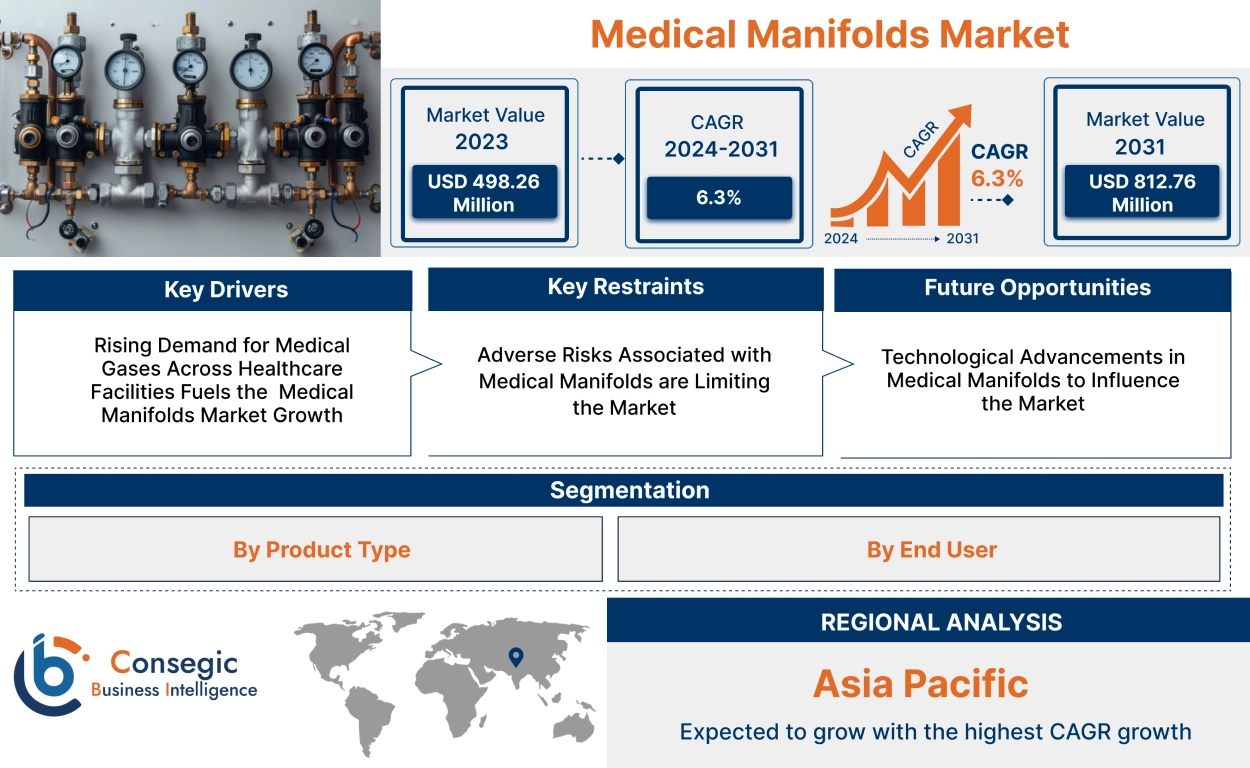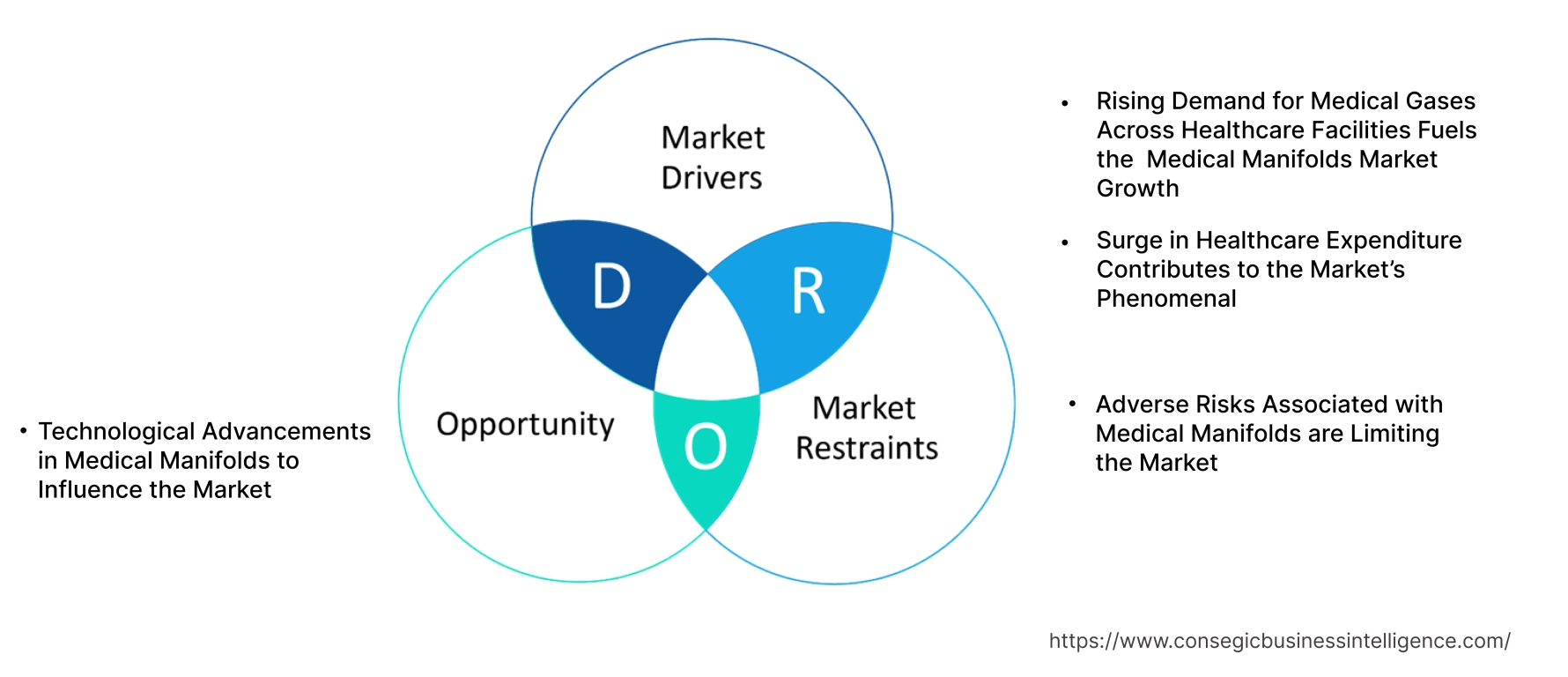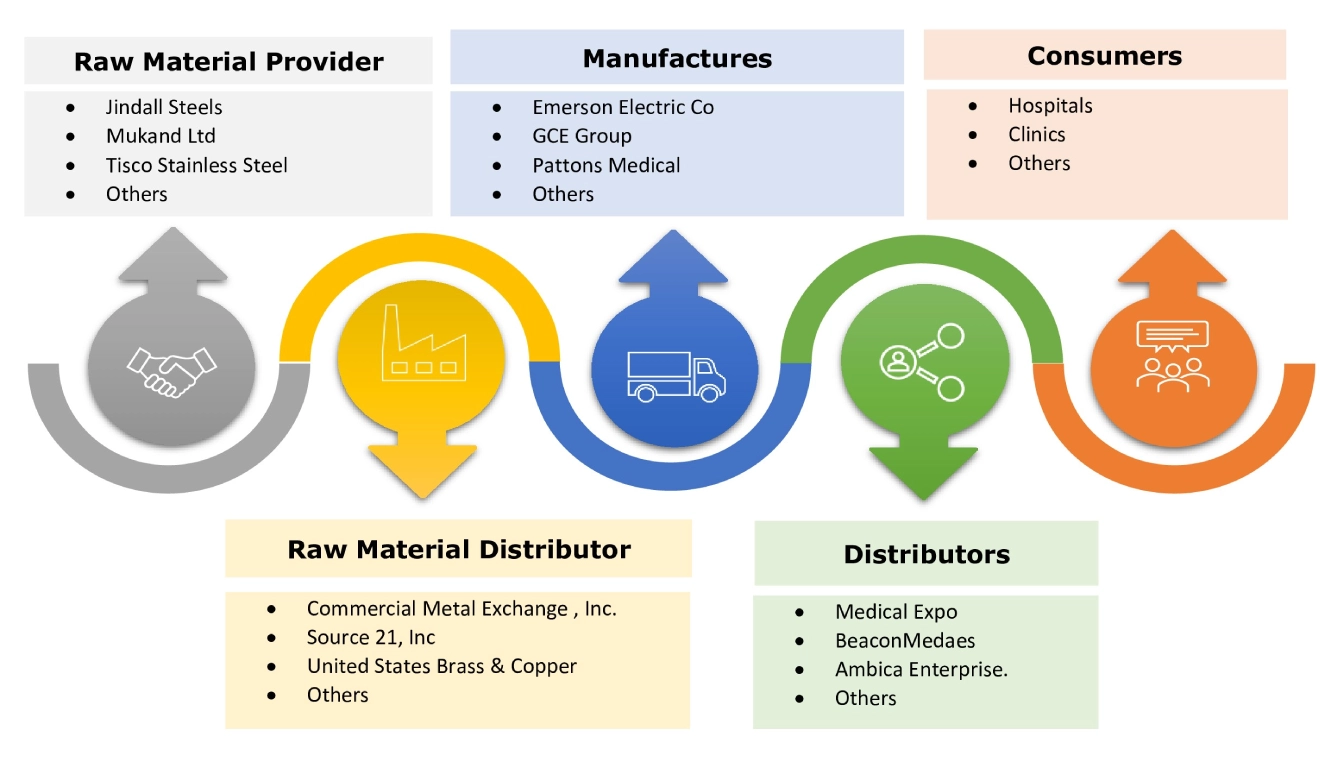- Summary
- Table Of Content
- Methodology
Medical Manifolds Market Size:
Consegic Business Intelligence analyzes that the medical manifolds market size is growing with a CAGR of 6.3% during the forecast period (2024-2031). The market accounted for USD 498.26 Million in 2023 and is projected to reach over USD 520.81 Million in 2024 and be valued at USD 812.76 Million by 2031.
Medical Manifolds Market Scope & Overview:
Medical manifolds are crucial components in healthcare facilities, serving as intricate systems that control, regulate, and distribute medical gases safely and efficiently to various points of use. These manifolds play a pivotal role in managing gases such as oxygen, nitrous oxide, nitrogen, and compressed air, among others, ensuring their precise delivery to medical devices and patient care areas. Their primary function is to consolidate multiple gas sources into a single supply point, facilitating the smooth operation of critical healthcare equipment. As per the analysis, these systems are meticulously designed to meet stringent industry standards and regulations, guaranteeing the reliability and safety of gas distribution within hospitals, clinics, and other healthcare settings. They incorporate advanced technologies and fail-safe mechanisms to monitor gas pressure, maintain consistent flow rates, and enable quick switching between gas sources, thereby supporting uninterrupted patient care.
The device-specific manifolds are tailored to the unique needs of various medical instruments, ensuring accurate gas supply and optimal functionality during surgical interventions, diagnostic procedures, and treatments. Based on the analysis, their design focuses on compatibility, precision, and reliability, enabling healthcare professionals to deliver targeted gas concentrations or pressures essential for patient care while adhering to stringent safety standards.
Thus, whether as centralized gas distribution systems or integrated within medical devices, they represent indispensable components in modern healthcare infrastructure. Their seamless operation, precision engineering, and adherence to safety standards are paramount in ensuring the reliable delivery of medical gases vital for patient care, diagnosis, and treatment across diverse medical facilities.
Medical Manifolds Market Insights:
Key Drivers:
Rising Demand for Medical Gases Across Healthcare Facilities Fuels the Medical Manifolds Market Growth
The escalating demand for medical gases is one of the prominent reasons fuelling the requirement for this manifold which is driving the market across the globe. Medical gases are an essential part of a variety of medical procedures, including surgery, anesthesia, and respiratory therapy among others. As per the analysis, the surge in the prevalence of respiratory diseases is enhancing the requirement for medical gases and thereby boosting the medical manifolds market since patients with such diseases need medical gasses.
- For instance, according to the data provided by the World Health Organization in November 2023, an estimated 392 million people are living with chronic obstructive pulmonary disease, claiming the lives of over 3 million people every year.
Thus, the rising incidences of respiratory disorders are significantly fueling the market.
Surge in Healthcare Expenditure Contributes to the Market's Phenomenal
The global healthcare infrastructure and the rising prevalence of chronic disorders have motivated the need for more medical accessories. Based on the analysis, the manifold is an important part that assists as the potential factor in various healthcare settings. The escalating healthcare expenditure is increasing the need for the development of healthcare infrastructure, leading to an increase in several hospitals and clinics that need to be equipped with manifolds.
- For instance, according to the data published by India Brand Equity Foundation in October 2023, India's public expenditure on healthcare touched 2.1 % of GDP in FY23 and 2.2% in FY22, against 1.6% in FY21, as per the Economic Survey 2022-23.
As a result, the consistent growth in public expenditure is propelling the need for manifold further fueling the market.
Key Restraints :
Adverse Risks Associated with Medical Manifolds are Limiting the Market
Disadvantages associated with the manifold are posing a significant challenge to the market. Medical gas manifolds encounter some serious risks including leaks, pressure failure, incorrect gas delivery, pressure failure, and malfunction of valves among others. One of the most concerning issues, i.e. gas leaks, may occur due to faulty connections, worn-out seals, or damage to the manifold itself which compromises oxygen delivery to patients, posing a critical safety risk.
Additionally, as per the analysis, faulty regulators, blockages in the system, or improper gas cylinder changes may result in uneven or inaccurate pressure affecting gas delivery and impacting patient care. Consequently, this erratic pressure leads to hypoxemia (low oxygen levels) or hyperoxemia (high oxygen levels), both potentially hazardous for patients. Furthermore, accessing manifolds for these maintenances within complex hospital settings is a challenging task, and skilled technicians are required for repairs. As a result, above mentioned risks with the manifold are posing a significant threat to the market.
Future Opportunities :
Technological Advancements in Medical Manifolds to Influence the Market
The development of smart manifolds with remote monitoring, predictive maintenance, and data analytics capabilities is expected to create new medical manifolds market opportunities. Smart manifolds equipped with these advanced features further drive significant operational improvements and cost savings.
The integration of predictive maintenance algorithms can further optimize operations by anticipating potential failures and scheduling maintenance accordingly, minimizing downtime. Additionally, as per the analysis, the ability to collect and analyze data from smart manifolds opens up new solutions for deeper insights into system performance. This data is integrated with broader building management or industrial IoT systems, enabling users to gain valuable insights and make more informed decisions. The potential for enhanced safety, compliance, and energy efficiency through smart manifold technologies is also expected to contribute to the market as organizations increasingly prioritize these capabilities.
- For instance, in July 2023 Emerson launched the ASCO Series 588 Stationary Oxygen Concentrator Manifold, the healthcare industry's first turnkey manifold solution designed to optimize respiratory therapy device designs and accelerate product speed to market. Oxygen concentrators must quickly reach patients who rely on them, so they must be readily available and operate reliably. The Series 588 manifold is specially designed to simplify device engineering and assembly and improve device energy efficiency, lifespan, and reliability.
Thus, the aforementioned factors will drive the market in the coming years.
Medical Manifolds Market Segmental Analysis :
By Product Type:
The product type is categorized into medical gas manifold and medical device manifold.
Trends in the Product Type:
- The rise in the incorporation of automated and smart manifold systems provides potential trends for the market.
- There is an emerging trend towards lightweight, disposable plastic medical device manifolds as an alternative to traditional metal manifolds.
In 2023, the medical gas manifold segment accounted for the highest medical manifolds market share of 68.18% of the medical manifolds market, and it is also expected to hold the fastest CAGR over the forecast period.
- The medical gas manifold is further segmented into Oxygen Manifold, Nitrogen oxide Manifold, Carbon dioxide Manifold, and Others.
- Medical gas manifolds are primarily utilized in respiratory therapies, anesthesia, dialysis, critical care, and other medical applications.
- Additionally, new product launches such as next-generation automatic manifold changeover systems are potentially boosting the medical manifolds market.
- In July 2023, BeaconMedaes announced the launch of its next-generation Automatic Manifold Changeover System, the MAT-S. This medical gas supply system combines a proven design with innovative new features such as higher utilization rate and uptime to deliver premium performance and reliability as well as lower operational and maintenance costs.
- As a result, based on the analysis, advancements in technology to improve the performance and maintenance cost of these manifolds are expected to create new opportunities for the segment soon.
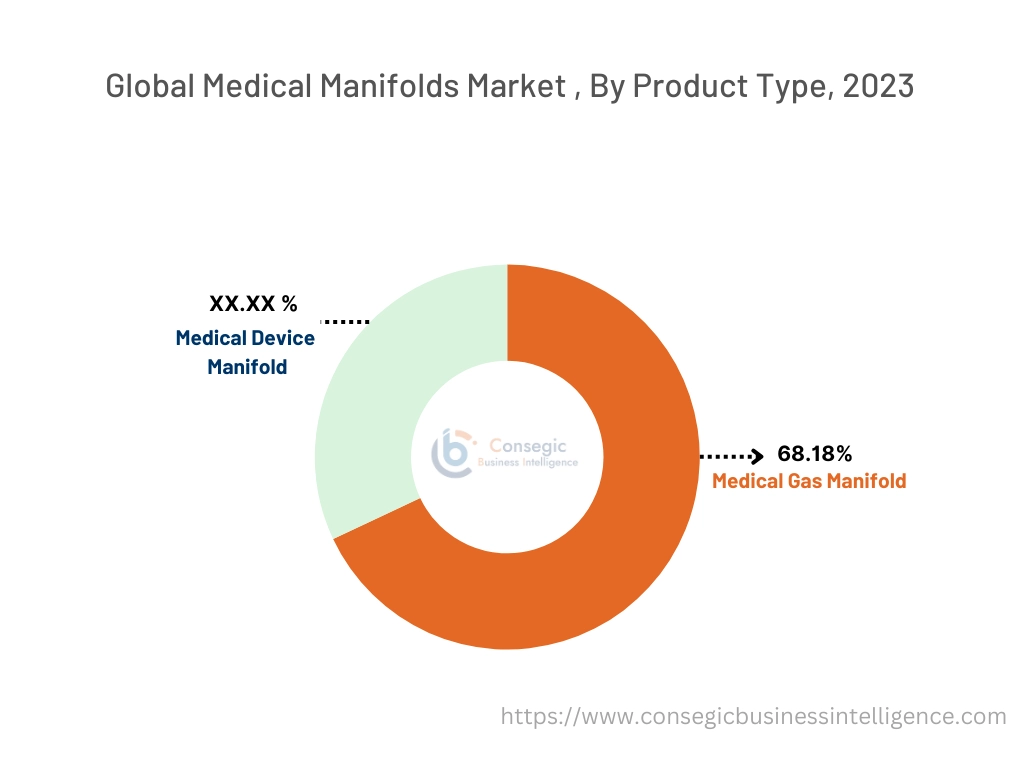
By End User:
The end-user segment is categorized into hospitals, clinics, ambulatory surgical centers, and others.
Trends in the end-user:
- End users are favoring more flexible manifold systems that are easily customized according to their specific needs and workflows creating possible trends for the segment.
- To ensure compliance with strict infection control regulations, there is a growing focus on manifold designs optimized for cleanliness and sterility in healthcare settings, thus possessing trends for the segment.
In 2023, the hospital segment accounted for the highest market share in the overall medical manifolds market trend.
- Hospitals are the primary users of the medical gas manifolds as they possess diverse departments with high patient volumes.
- In these facilities, different specializations require multiple types of manifolds to meet their gas needs.
- Additionally, the rising number of surgeries and a growing geriatric population are boosting the requirement for medical gas manifolds.
- According to the data published by the European Commission, in August 2023, reported that at least 1.14 million cesarean sections, which come under surgeries, were performed in the Europe region in 2021.
- Thus, the aforementioned factors are propelling the segment expansion.
The clinic segment is expected to hold the fastest CAGR over the forecast period.
- The rising requirement for outpatient procedures in specialty clinics that are focused on dental, surgical, and pain management is expected to increase the utilization of gas manifolds for specific needs.
- These clinics often rely on device-specific manifolds suited to their area of expertise, leading to targeted trends.
- In addition to this, the convenience and cost-effectiveness of the procedures provided by clinics are expected to boost the market.
- Additionally, increasing government investment in healthcare services is expected to push the medical manifolds market demand across the clinics.
- In February 2023, the Government of Canada announced a substantial investment of USD 196.1 billion over the next decade, which includes USD 46.2 billion in new funding aimed at enhancing healthcare services across provinces and territories for Canadians As a result, this government investment is expected to propel the usage of manifolds across the clinics driving the medical manifolds market growth.
Regional Analysis:
The regional segment includes North America, Europe, Asia Pacific, the Middle East and Africa, and Latin America.
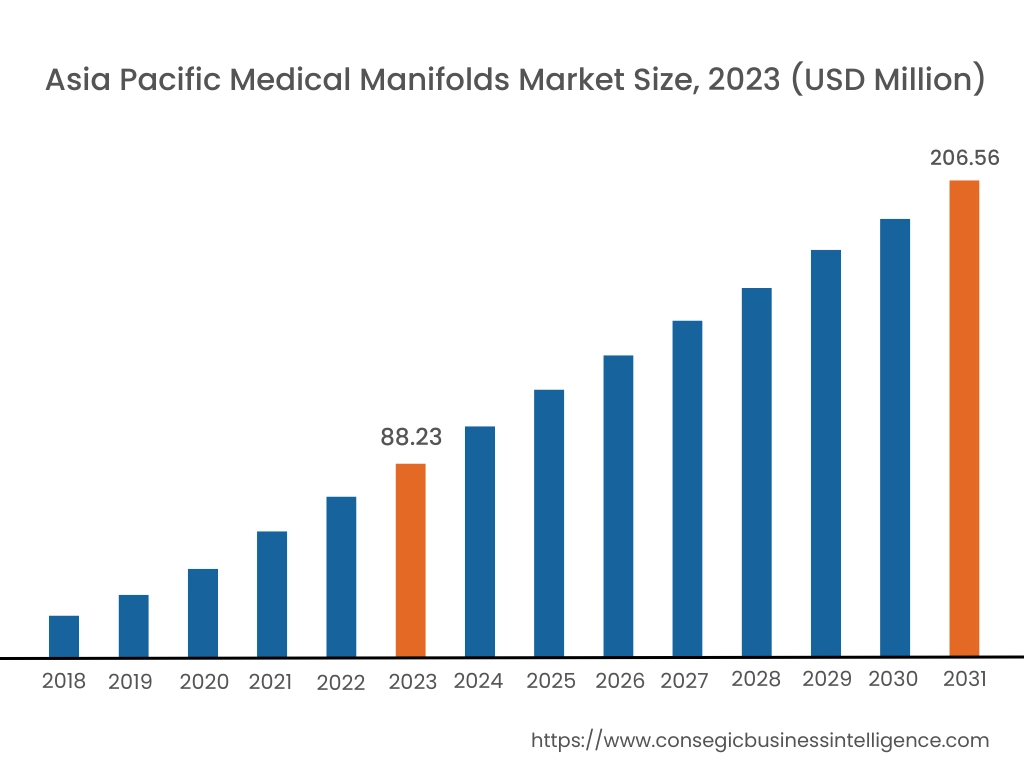
The Asia Pacific region is expected to witness significant growth over the forecast period, growing at a CAGR of 11.2% during 2024-2031. In Asia Pacific, China accounted for a major market revenue of 44.3% in 2023.
The significant growth in healthcare infrastructure development and the increasing adoption of advanced medical technologies across the region are expected to increase the demand for these manifolds throughout the zone. In addition to this, the rising hospital revenue in this region is expected to push the market.
- According to the data provided by the National Investment Promotion and Facilitation Agency in December 2023, the hospital sector revenue in India is valued at USD 95.45 billion in the financial year 2021 and it is expected to reach USD 220.56 billion by the financial year 2027, growing at a CAGR of 18.24%.
The above-mentioned factors are collectively driving the demand for these manifolds in the Asia Pacific region and creating lucrative growth opportunities for the medical manifolds market.
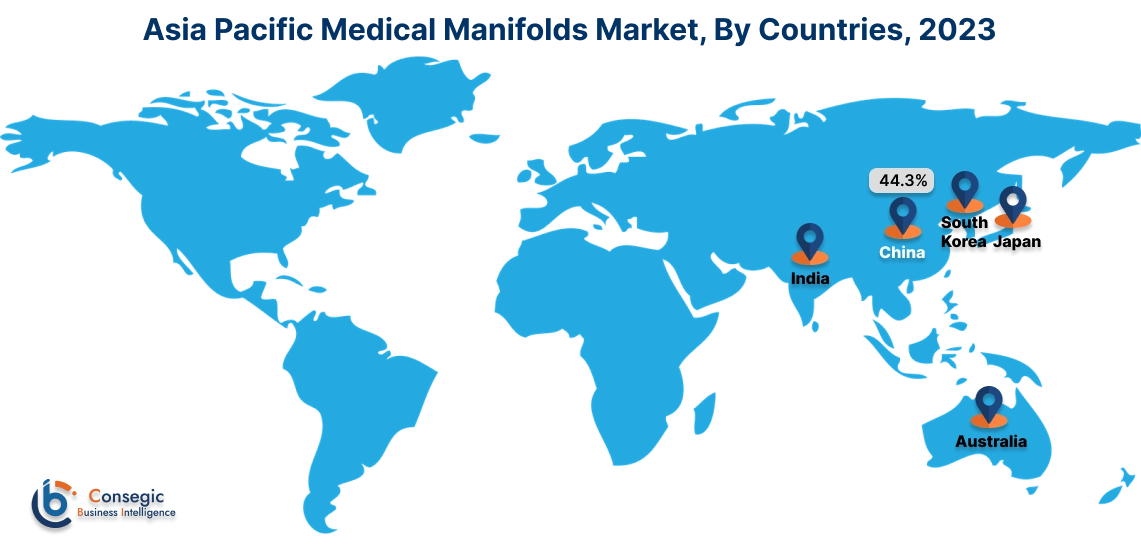
North America accounted for the highest Medical Manifolds Market share valued at USD 148.12 Million in 2023 and it is expected to reach USD 327.99 Million in 2031. The medical manifolds market across the North American region is growing owing to the availability of well-established healthcare infrastructure and a strong presence of medical gas companies across the region.
Additionally, the rise in chronic respiratory diseases and increasing surgical procedures are escalating the demand for medical gases causing significant market growth. Moreover, high healthcare expenditure allows for investments in these manifolds further fueling the market.
- According to the U.S. Department of Health & Human Services, the number of adults who have been diagnosed with chronic respiratory conditions, COPD, emphysema, or chronic bronchitis is 4.6%.
As per the medical manifolds market analysis, Europe is anticipated to witness a substantial rise that is backed by the increasing adoption of medical manifolds in healthcare sectors. Companies are investing in innovative technologies to cater to the surging demand for these manifolds across the region.
The Middle East, Africa, and Latin America are expected to grow at a considerable rate due to increasing investments in digital infrastructure and medical sectors in countries like Brazil, and UAE, among others.
Top Key Players & Market Share Insights:
The global Medical manifolds market is highly competitive, with several large players and numerous small and medium-sized enterprises. These companies have strong research and development capabilities and a strong presence in the market through their extensive product portfolios and distribution networks. The medical manifolds industry is characterized by intense competition, with companies focusing on expanding their product offerings and increasing their market share through mergers, acquisitions, and partnerships. The key players in the market include-
- Acme Cryo.(U.S)
- B. Braun SE (Germany)
- GCE Group (UK)
- ASB Medical System Pvt. Ltd.(India)
- Schönn Medizintechnik GmbH (Germany)
- Pattons Medical (U.S)
- Advin Health Care(India)
- Atlas Copco AB (Sweden)
- POWEREX (Canada)
- Emerson Electric Co.(U.S.)
Recent Industry Developments :
Product Launches:
- In July 2023, Emerson announced the launch of the ASCO Series 588 Stationary Oxygen Concentrator Manifold. It's the healthcare industry's first turnkey manifold solution designed to optimize respiratory therapy device designs and accelerate product speed to market. The Series 588 manifold is specially designed to simplify device engineering and assembly and improve device energy efficiency, lifespan, and reliability.
Mergers & Acquisitions:
- In March 2023, Atlas Copco announced the acquisition of the operating assets of FS Medical Technology Business (FS Medical), based in California, USA. The business services, sells, verifies, and tests piped medical and laboratory gas equipment and systems. The business will be integrated into BeaconMedaes LLC, which is part of the Medical Gas Solutions Division in the Compressor Technique Business Area.
Medical Manifolds Market Report Insights :
| Report Attributes | Report Details |
| Study Timeline | 2018-2031 |
| Market Size in 2031 | USD 812.76 Million |
| CAGR (2024-2031) | 6.3% |
| By Treatment |
|
| By End User |
|
| By Region |
|
| Key Players |
|
| North America | U.S. Canada Mexico |
| Europe | U.K. Germany France Spain Italy Russia Benelux Rest of Europe |
| APAC | China South Korea Japan India Australia ASEAN Rest of Asia-Pacific |
| Middle East and Africa | GCC Turkey South Africa Rest of MEA |
| LATAM | Brazil Argentina Chile Rest of LATAM |
| Report Coverage |
|
Key Questions Answered in the Report
How big was the Medical Manifolds Market in 2023? +
In 2023, the market size of Medical Manifolds was USD 812.76 million.
What is the fastest-growing region in the Medical Manifolds market? +
The Asia Pacific region is the fastest-growing region.
What specific segmentation details are covered in the Medical Manifolds report? +
The segment details covered consist of product type and end user.
Which are the key players in the Medical Manifolds Market? +
The key players include Acme Cryo., B. Braun SE, GCE Group, Pattons Medical, Advin Health Care, Atlas Copco AB, ASB Medical System Pvt. Ltd., Schönn Medizintechnik GmbH, POWEREX, Emerson Electric Co.
